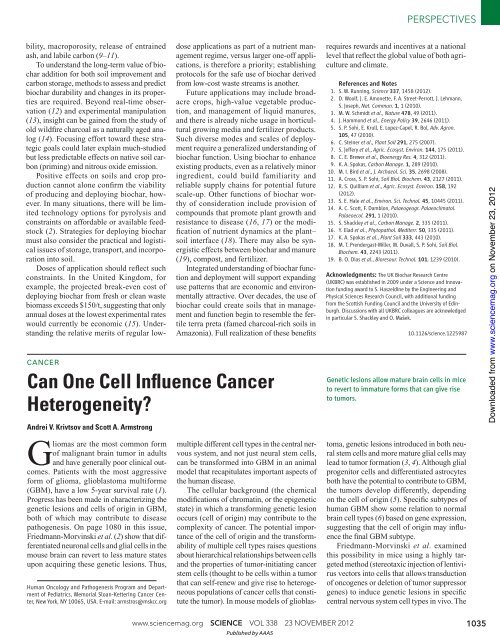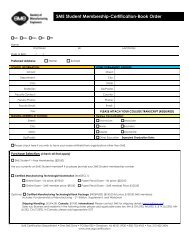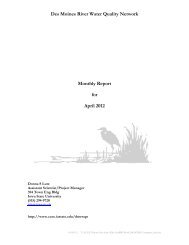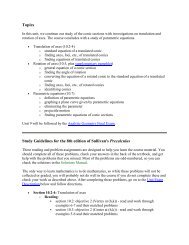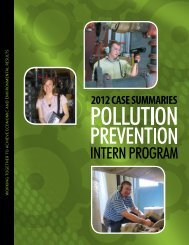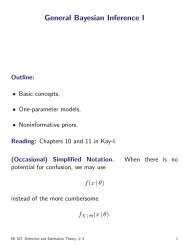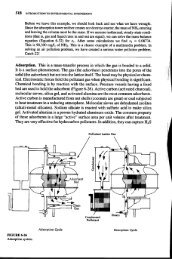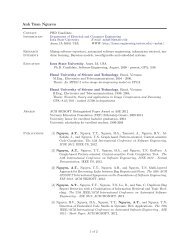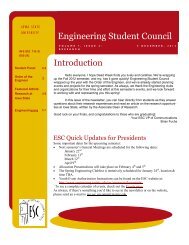DOI: 10.1126/science.1225987 , 1034 (2012); 338 Science Saran P ...
DOI: 10.1126/science.1225987 , 1034 (2012); 338 Science Saran P ...
DOI: 10.1126/science.1225987 , 1034 (2012); 338 Science Saran P ...
You also want an ePaper? Increase the reach of your titles
YUMPU automatically turns print PDFs into web optimized ePapers that Google loves.
ility, macroporosity, release of entrained<br />
ash, and labile carbon ( 9– 11).<br />
To understand the long-term value of biochar<br />
addition for both soil improvement and<br />
carbon storage, methods to assess and predict<br />
biochar durability and changes in its properties<br />
are required. Beyond real-time observation<br />
( 12) and experimental manipulation<br />
( 13), insight can be gained from the study of<br />
old wildfi re charcoal as a naturally aged analog<br />
( 14). Focusing effort toward these strategic<br />
goals could later explain much-studied<br />
but less predictable effects on native soil carbon<br />
(priming) and nitrous oxide emission.<br />
Positive effects on soils and crop production<br />
cannot alone confi rm the viability<br />
of producing and deploying biochar, however.<br />
In many situations, there will be limited<br />
technology options for pyrolysis and<br />
constraints on affordable or available feedstock<br />
( 2). Strategies for deploying biochar<br />
must also consider the practical and logistical<br />
issues of storage, transport, and incorporation<br />
into soil.<br />
Doses of application should refl ect such<br />
constraints. In the United Kingdom, for<br />
example, the projected break-even cost of<br />
deploying biochar from fresh or clean waste<br />
biomass exceeds $150/t, suggesting that only<br />
annual doses at the lowest experimental rates<br />
would currently be economic ( 15). Understanding<br />
the relative merits of regular low-<br />
dose applications as part of a nutrient management<br />
regime, versus larger one-off applications,<br />
is therefore a priority; establishing<br />
protocols for the safe use of biochar derived<br />
from low-cost waste streams is another.<br />
Future applications may include broadacre<br />
crops, high-value vegetable production,<br />
and management of liquid manures,<br />
and there is already niche usage in horticultural<br />
growing media and fertilizer products.<br />
Such diverse modes and scales of deployment<br />
require a generalized understanding of<br />
biochar function. Using biochar to enhance<br />
existing products, even as a relatively minor<br />
ingredient, could build familiarity and<br />
reliable supply chains for potential future<br />
scale-up. Other functions of biochar worthy<br />
of consideration include provision of<br />
compounds that promote plant growth and<br />
resistance to disease ( 16, 17) or the modifi<br />
c a t i o n o f n u t r i e n t d y n a m i c s a t t h e p l a n t –<br />
soil interface ( 18). There may also be synergistic<br />
effects between biochar and manure<br />
( 19), compost, and fertilizer.<br />
Integrated understanding of biochar function<br />
and deployment will support expanding<br />
use patterns that are economic and environmentally<br />
attractive. Over decades, the use of<br />
biochar could create soils that in management<br />
and function begin to resemble the fertile<br />
terra preta (famed charcoal-rich soils in<br />
Amazonia). Full realization of these benefi ts<br />
CANCER<br />
Can One Cell Infl uence Cancer<br />
Heterogeneity?<br />
Andrei V. Krivtsov and Scott A. Armstrong<br />
Gliomas are the most common form<br />
of malignant brain tumor in adults<br />
and have generally poor clinical outcomes.<br />
Patients with the most aggressive<br />
form of glioma, glioblastoma multiforme<br />
(GBM), have a low 5-year survival rate ( 1).<br />
Progress has been made in characterizing the<br />
genetic lesions and cells of origin in GBM,<br />
both of which may contribute to disease<br />
pathogenesis. On page 1080 in this issue,<br />
Friedmann-Morvinski et al. ( 2) show that differentiated<br />
neuronal cells and glial cells in the<br />
mouse brain can revert to less mature states<br />
upon acquiring these genetic lesions. Thus,<br />
Human Oncology and Pathogenesis Program and Department<br />
of Pediatrics, Memorial Sloan-Kettering Cancer Center,<br />
New York, NY 10065, USA. E-mail: armstros@mskcc.org<br />
multiple different cell types in the central nervous<br />
system, and not just neural stem cells,<br />
can be transformed into GBM in an animal<br />
model that recapitulates important aspects of<br />
the human disease.<br />
The cellular background (the chemical<br />
modifi cations of chromatin, or the epigenetic<br />
state) in which a transforming genetic lesion<br />
occurs (cell of origin) may contribute to the<br />
complexity of cancer. The potential importance<br />
of the cell of origin and the transformability<br />
of multiple cell types raises questions<br />
about hierarchical relationships between cells<br />
and the properties of tumor-initiating cancer<br />
stem cells (thought to be cells within a tumor<br />
that can self-renew and give rise to heterogeneous<br />
populations of cancer cells that constitute<br />
the tumor). In mouse models of glioblas-<br />
PERSPECTIVES<br />
requires rewards and incentives at a national<br />
level that refl ect the global value of both agriculture<br />
and climate.<br />
References and Notes<br />
1. S. W. Running, <strong>Science</strong> 337, 1458 (<strong>2012</strong>).<br />
2. D. Woolf, J. E. Amonette, F. A. Street-Perrott, J. Lehmann,<br />
S. Joseph, Nat. Commun. 1, 1 (2010).<br />
3. M. W. Schmidt et al., Nature 478, 49 (2011).<br />
4. J. Hammond et al., Energy Policy 39, 2646 (2011).<br />
5. S. P. Sohi, E. Krull, E. Lopez-Capel, R. Bol, Adv. Agron.<br />
105, 47 (2010).<br />
6. C. Steiner et al., Plant Soil 291, 275 (2007).<br />
7. S. Jeffery et al., Agric. Ecosyst. Environ. 144, 175 (2011).<br />
8. C. E. Brewer et al., Bioenergy Res. 4, 312 (2011).<br />
9. K. A. Spokas, Carbon Manage. 1, 289 (2010).<br />
10. M. I. Bird et al., J. Archaeol. Sci. 35, 2698 (2008).<br />
11. A. Cross, S. P. Sohi, Soil Biol. Biochem. 43, 2127 (2011).<br />
12. R. S. Quilliam et al., Agric. Ecosyst. Environ. 158, 192<br />
(<strong>2012</strong>).<br />
13. S. E. Hale et al., Environ. Sci. Technol. 45, 10445 (2011).<br />
14. A. C. Scott, F. Damblon, Palaeogeogr. Palaeoclimatol.<br />
Palaeoecol. 291, 1 (2010).<br />
15. S. Shackley et al., Carbon Manage. 2, 335 (2011).<br />
16. Y. Elad et al., Phytopathol. Mediterr. 50, 335 (2011).<br />
17. K. A. Spokas et al., Plant Soil 333, 443 (2010).<br />
18. M. T. Prendergast-Miller, M. Duvall, S. P. Sohi, Soil Biol.<br />
Biochem. 43, 2243 (2011).<br />
19. B. O. Dias et al., Bioresour. Technol. 101, 1239 (2010).<br />
Acknowledgments: The UK Biochar Research Centre<br />
(UKBRC) was established in 2009 under a <strong>Science</strong> and Innovation<br />
funding award to S. Haszeldine by the Engineering and<br />
Physical <strong>Science</strong>s Research Council, with additional funding<br />
from the Scottish Funding Council and the University of Edinburgh.<br />
Discussions with all UKBRC colleagues are acknowledged<br />
in particular S. Shackley and O. Mašek.<br />
<strong>10.1126</strong>/<strong>science.1225987</strong><br />
Genetic lesions allow mature brain cells in mice<br />
to revert to immature forms that can give rise<br />
to tumors.<br />
toma, genetic lesions introduced in both neural<br />
stem cells and more mature glial cells may<br />
lead to tumor formation ( 3, 4). Although glial<br />
progenitor cells and differentiated astrocytes<br />
both have the potential to contribute to GBM,<br />
the tumors develop differently, depending<br />
on the cell of origin ( 5). Specifi c subtypes of<br />
human GBM show some relation to normal<br />
brain cell types ( 6) based on gene expression,<br />
suggesting that the cell of origin may infl uence<br />
the fi nal GBM subtype.<br />
Friedmann-Morvinski et al. examined<br />
this possibility in mice using a highly targeted<br />
method (stereotaxic injection of lentivirus<br />
vectors into cells that allows transduction<br />
of oncogenes or deletion of tumor suppressor<br />
genes) to induce genetic lesions in specifi c<br />
central nervous system cell types in vivo. The<br />
www.sciencemag.org SCIENCE VOL <strong>338</strong> 23 NOVEMBER <strong>2012</strong> 1035<br />
Published by AAAS<br />
on November 23, <strong>2012</strong><br />
www.sciencemag.org<br />
Downloaded from


